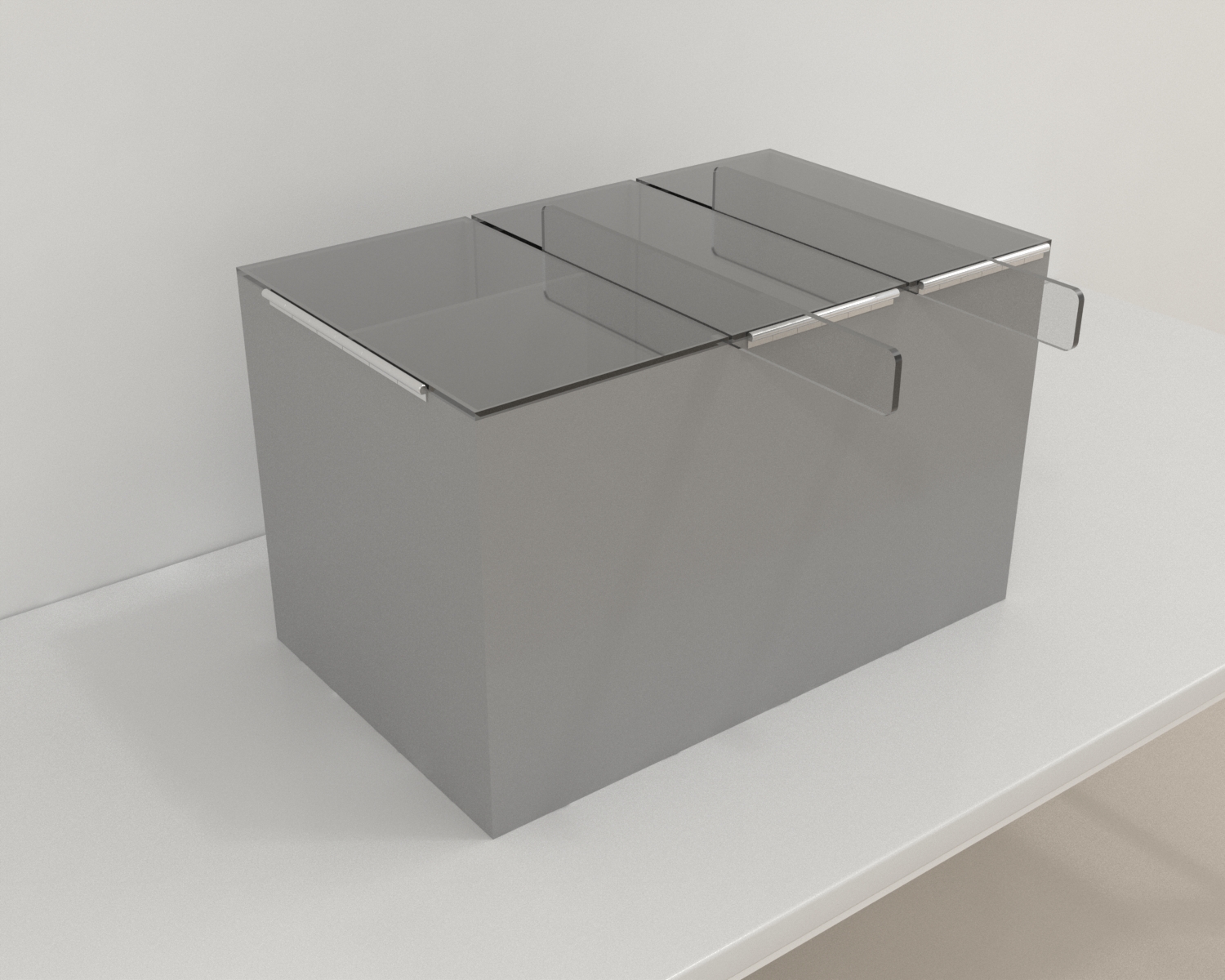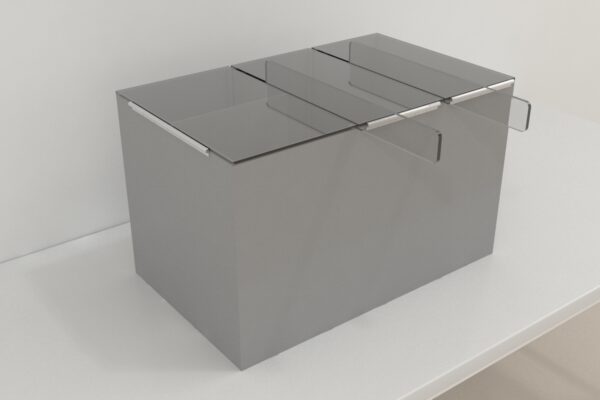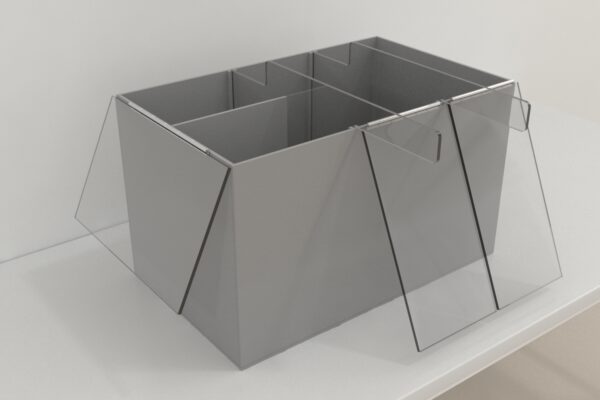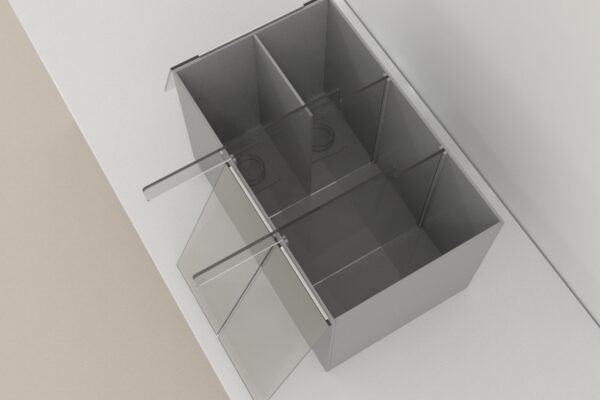As an adaptation to the Dig Task and Attentional Set Shifting (IDED) Chamber, the Neuwirth-BrownTM Attention Set-shift Test (ASST) utilizes basic scent and textural discrimination paradigms to assess cognitive deficits. Cited in over 135 publications Tait et al. (2018)[1], the ASST was developed from the traditional Birrel and Brown (2000) apparatus and paradigms to better assess rodent behavior associated with cognition and fronto-executive functions.
The aim of the original study using the ASST was to better assess the effect of lead (pb2+)- induced frontal executive dysfunctions and subsequent higher-order cognitive and behavioral systems (Neurwirth et al., 2019), the protocol was adapted from Birrell and Brown’s (2000) Attention Set-Shift Test (ASST)[2]. The ASST was developed to study perceptual attention and the involvement of the medial frontal cortex in rodents (Birrell &and Brown., 2000). The adaptations to the ASST test addresses limitations of this task in guiding rodents’ context-specific behaviors to include measurement of parameters not usually measured using this apparatus such as latency to eat the food reward and time holding food reward before eating. With adaptations to these protocols, clearer additional nuanced relationships between prefrontal attentional mechanisms, frontal executive behaviors, and correlating neurochemical processes are addressed to ascertain how each system underlying the frontal neural networks differentially and cooperatively guide goal-directed behaviors in normal and pathological conditions.
Price & Dimensions
Bowl Digging Paradigm Test for Mouse
$ 2990
Per Month- Principal chamber: 14 x 8.5 x 8 inches
- The principal chamber is split into three sections for the placement of acrylic walls
- First 2 sections: 4.25 x 8.25 inches
- Last sections: 5.5 x 4 inches with 1/4 inch wall in between
- Flip-up lids x2 for the first 2 sections: 8.75 x 4.25 (a 0.75-inch gap between each lid)
- Placement of food bowl within last 2 sections: 0.75 inches from the end
- Food bowls x 12: 1.75 inch diameter x 0.875 inch plexiglass
Bowl Digging Paradigm Test for Rats
$ 3290
Per Month- Principal chamber: 28 x 16.5 x 16. Inch
- The principal chamber is split into three sections for the placement of acrylic walls
- First 2 sections: 8.5 x 16.5 inches
- Last sections: 11 x 8 inches with ½ inch wall in between
- Flip-up lids x2 for the first 2 sections: 17.5 x 8.5 (a 1.5-inch gap between each lid)
- Placement of food bowl within last 2 sections: 1.5 inches from the end
- Food bowls x 24: 3.5 inch diameter x 1.75 inch plexiglass
Introduction
The product specifications and training protocol for the Neuwirth-BrownTM Attention Set-shift Test (ASST) has been adapted from the traditional Attention Set-Shift Test (ASST) (Birrell & Brown, 2000) to expand the protocol over four days rather than 10 hours to increase motivation, momentum, and less exhaustion in rodent test subjects; thus, reducing the chance of extra-strenuous variables. The apparatus is lit at 100-200 lux to prevent anxiogenic responses (see, For Review Neuwirth et al., 2022).
Birrell and Brown (2000) created the first Attention Set-Shift Test (ASST) and Neuwirth and Brown in 2017 developed the Neuwirth-Brown™ Attention Set-shift Test (ASST). Using these adapted apparatuses, the accuracy and number of parameters that can be explored in rodent higher-order cognitive and behavioral systems were greatly improved.
Apparatus & Equipment
The Neuwirth-BrownTM Attention Set-shift Test (ASST) consists of a chamber measuring 28 x 16.5 x 16 inches. The chamber is split into three sections for the placement of acrylic walls, with the two first sections measuring 8.5 x 16.5 inches and the last sections measuring 11 x 8 inches with 1/2 inch wall in between. The apparatus has two flip-up lids for the first 2 sections measuring 17.5 x 8.5 inches with a 1.5-inch gap between each lid. There is the placement of food bowl within last 2 sections, 1.5 inches from the end and 24 food bowls measuring 3.5 inches diameter x 1.75-inch plexiglass material.
Training Protocol
Clean the apparatus after every trial to prevent odor cues from previous trials affecting task performance. Appropriately light the apparatus. A tracking and recording system such as BehaviorCloud can be used to assist with observations.
Pre-training for the Neuwirth-Brown™ Attention Set-shift Test (ASST)
- Test rodents are deprived of food for two weeks as recommended by NIH approved food restriction schedule. This was to create a steady metabolic state in the test rodents and to provide motivation to search and consume food rewards
- Dig training: Rodents were trained in a single session within the digging apparatus to retrieve a food reward within an increasing amount of shredded paper in a sequence of retrieval of food from bowls with:
- 25% shredded paper
- 50% shredded paper
- 75% shredded paper
- 100% shredded paper
- Rodents need to complete ten trails of successful dig sequences and food rewards before moving onto the next sequence to meet “dig trained” criteria.
- Test training: Dig-trained rodents were given a four-day test schedule. In the digging apparatus, rodents were given two-choice pair stimulus of food bowls covered in food reward dust to prevent rodents from identifying the food reward based on odor alone. Rodents completing correct food reward bowl determination six times in a row met the criteria to move onto subsequent testing.
Neuwirth-Brown™ Attention Set-shift Test (ASST) Paradigm Testing
- Test day 1: Rodents are placed in the digging apparatus and presented with a set of two-choice pair stimuli which consists of two novel odor stimuli or novel tactile digging medium. Rats were tasked to associate which stimulus was paired with a food reward.
- Test day 2: Rodents were presented with two new two-choice pair stimuli. Further discriminations were made by rodents to two-choice pair stimuli with combinations of two odor and two digging mediums at once with one food reward.
- Complex discrimination reversal can be examined in reversing the two-choice pair stimuli food reward combinations
- Test day 3: Complex discrimination reversal is re-tested. To generalize learning, the rodent is tested with the third set of novel stimuli pairings as an interdimensional shift or the same relevant stimulus dimension as the prior test day. This is followed by an interdimensional reversal.
- Test day 4: Intradimensional reversal is re-tested again with a learning re-acquisition probe in which the rodent is presented with the fourth set of novel stimuli pairings to follow previously irrelevant stimulus dimension (eg. if the rodent was previously following an odor stimulus, it would shift to a digging medium stimulus. This is an extradimensional shift, followed by an extradimensional reversal.
Data Analysis
These parameters can be measured using manual scoring mechanisms and video tracking:
- Time taken to reach the food reward bowl.
- Time taken to approach food reward bowl.
- Correct discrimination of the food reward versus non-food reward.
- Latency to eat food reward.
- Time taken to consume food.
Literature Review
Assessment of intradimensional/extradimensional attentional set-shifting in rats
Tait et al. (2018) evaluated the use of the ASST in rats and the different protocols and methodologies different groups have used to assess the interdimensional/extradimensional (ID/ED) attentional set-shifting task, which assesses the ability of rats to switch attention between different aspects of a stimulus, such as a shape and color. The aim was to establish a standardized protocol for the ASST. It was found that despite differences in protocols and methodology, these differences did little to affect the consistency of results.
The medial frontal cortex mediates perceptual attentional set-shifting in the rat
Birrel and Brown (2000) examined the role of the medial frontal cortex on the rat’s ability to shift attention between different perceptual cues using the Attention Set-shift Test (ASST). Results found that the rodent medial frontal cortex plays a key role in the process of shifting attention and mediates the process of switching between different perceptual sets. The findings of this study concluded that the medial frontal cortex of the rat has functional similarity to the primate lateral prefrontal cortex. This contributes to our understanding of the neural mechanisms underlying attention and could have implications for the treatment of attention-related disorders in both animals and humans.
Early Neurodevelopmental Exposure to Low Lead Levels Induces Fronto-executive Dysfunctions That Are Recovered by Taurine Co-treatment in the Rat Attention Set-Shift Test: Implications for Taurine as a Psychopharmacotherapy Against Neurotoxicants
Using the ASST, Neuwirth et al (2019a) investigated the effects of early exposure to low levels of lead on the development of frontal executive functions in rats, and if the amino acid Taurine could mitigate these effects. The results showed that early exposure to lead caused impairments in frontal executive functions, as measured using the ASST. When the rats were given Taurine and exposed to lead, frontal executive impairments were recovered (Neuwirth et al., 2019b). The Neuwirth et al. (2019b) study suggests that taurine may be an effective psychopharmacotherapy against neurotoxicants like lead, and could potentially be used to mitigate the negative effects of lead exposure on brain development and function.
Low-level lead exposure impairs fronto-executive functions: A call to update the DSM–5 with lead poisoning as a neurodevelopmental disorder
Neuwirth et al (2020) presented two decades’ worth of compiled evidence to conclude that even at low levels, lead exposure can damage the brain and result in negative impacts on cognitive and behavioral development, particularly disrupting frontal executive functions such as decision-making, planning, and attention. The authors concluded that greater awareness and action to prevent lead exposure and for the inclusion of lead poisoning as a neurodevelopmental disorder in the Diagnostic and Statistical Manual of Mental Disorders (DSM-5). The results of this study highlight the importance of addressing lead exposure in order to protect brain development and function.
Strengths & Limitations
Strengths
With adapted protocols to the traditional dig task and ASST, the Neuwirth-BrownTM Attention Set-shift Test (ASST) and associated protocols increase the number of parameters that can be explored in rodent higher-order cognitive and behavioral systems such as frontoexecutive functions. The Bowl Digging Paradigm Test allows for the investigation of rodent behavior in the interdisciplinary fields of neuroscience, neuropsychology, neuropsychiatry, and neuropsychopharmacology.
Limitations
After each trial, the apparatus, food bowls, food rewards, odor cues, and digging materials must be replaced and cleaned to prevent lingering odor cues from previous trials from affecting task performance. For training and examination, the subjects’ age, gender, or strain can affect the way they perform the task. Stress from inappropriate or aggressive handling of the subjects can affect task performance. Unintentional stimuli may interfere with task performance.
References
-
- Birrell JM, & Brown VJ. Medial frontal cortex mediates perceptual attentional set-shifting in the rat. J Neurosci. 2000 Jun 1;20(11):4320-4. DOI: 10.1523/JNEUROSCI.20-11-04320.2000. PMID: 10818167; PMCID: PMC6772641.
- Tait, D. S., Bowman, E. M., Neuwirth, L. S., & Brown, V. J. (2018). Assessment of intradimensional/extradimensional attentional set-shifting in rats. Neuroscience & Biobehavioral Reviews, 89, 72-84. https://doi.org/10.1016/j.neubiorev.2018.02.013
- Neuwirth, L.S., Masood, S., Anderson, D.W. & Schneider, J.S. (2019a). The attention set-shifting test is sensitive for revealing sex-based impairments in executive functions following developmental lead exposure in rats. Behavioural Brain Research. 366, 126-134. https://doi.org/10.1016/j.bbr.2019.03.022.
- Neuwirth, L.S., Kim, Y., Barrera, E., Jo, C., Chrisphonte, J.M., Hameed, N., Rubi, S., Dacius Jr., T.F., Skeen, J., Bonitto, J.R., Khairi, E., Iqbal, A., Ahmed, I., Masood, S., Tranquille, B. & Thiruverkadu, V. (2019b). Early neurodevelopmental exposure to low lead levels induces frontoexecutive dysfunctions that are recovered by the co-treatment of taurine in the rat attention set-shift test: Implications for taurine as a psychopharmacotherapy against neurotoxicants. In J. Hu, P. Fengyuan, S.W. Schaffer, A. El Idrissi & J.Y. Wu (Eds.), Taurine 11, Advances in Experimental Medicine & Biology, Vol. 1155: 821-846. New York, NY: Springer Press. https:/doi.org/10.1007/978-981-13-8023-5_70 Neuwirth, L.S. & Emenike, B.U. (2020). Compositions and methods of treating a subject with taurine and derivatives thereof. Inv. Ref. 200-2067US01. Serial No. 16/880,796 U.S. Patent Application. https://patentimages.storage.googleapis.com/45/79/4b/df580ac87b471d/US20210069134A1.pdf
- Neuwirth, L. S., Verrengia, M. T., I., Z., Orens, J. E., & Lopez, O. E. (2022). Under or Absent Reporting of Light Stimuli in Testing of Anxiety-Like Behaviors in Rodents: The Need for Standardization. Frontiers in Molecular Neuroscience, 15. https://doi.org/10.3389/fnmol.2022.912146
- Neuwirth, L. S., Lopez, O. E., Schneider, J. S., & Markowitz, M. E. (2020). Low-level lead exposure impairs fronto-executive functions: A call to update the DSM–5 with lead poisoning as a neurodevelopmental disorder. Psychology & Neuroscience, 13(3), 299–325. https://doi.org/10.1037/pne0000225





